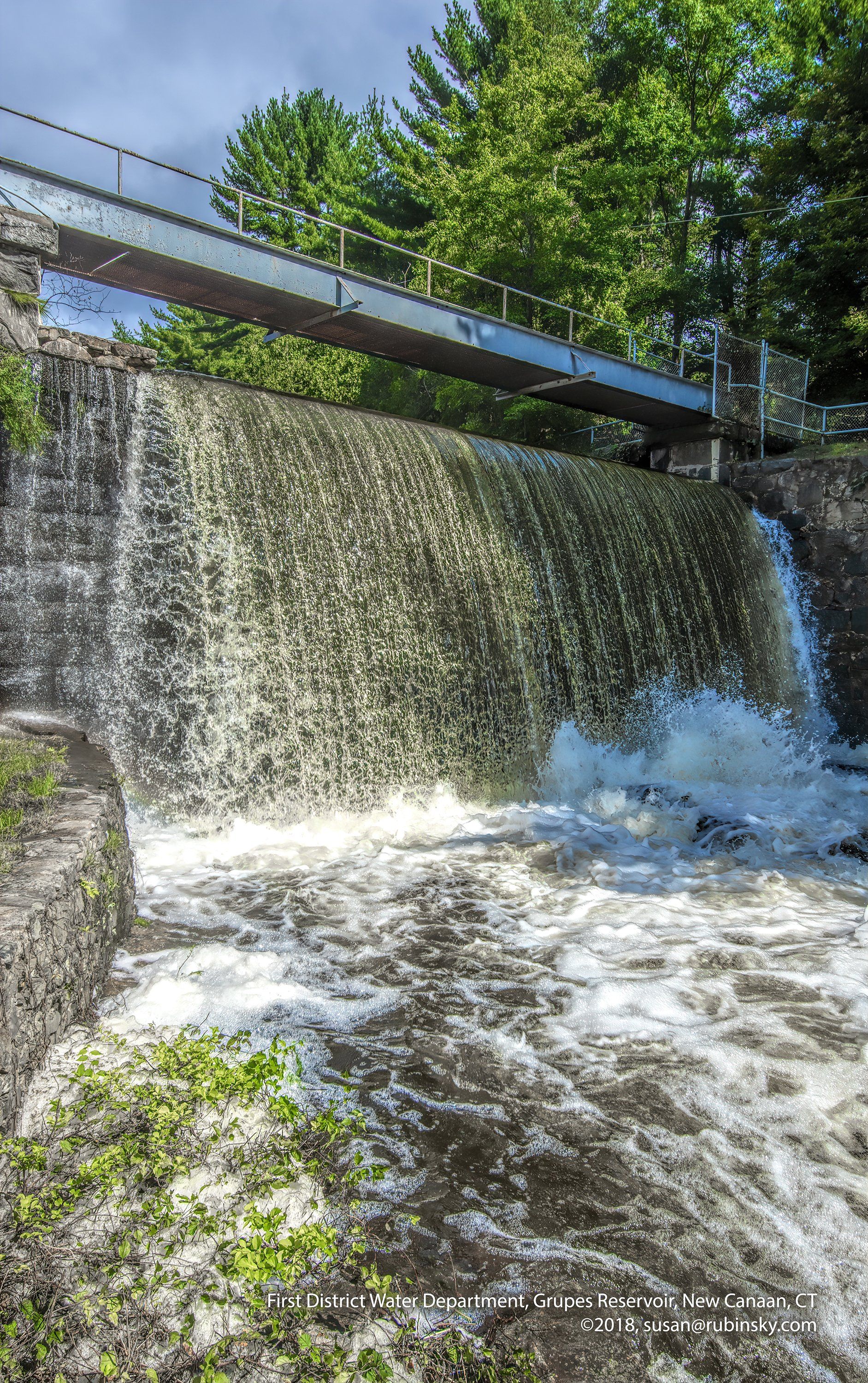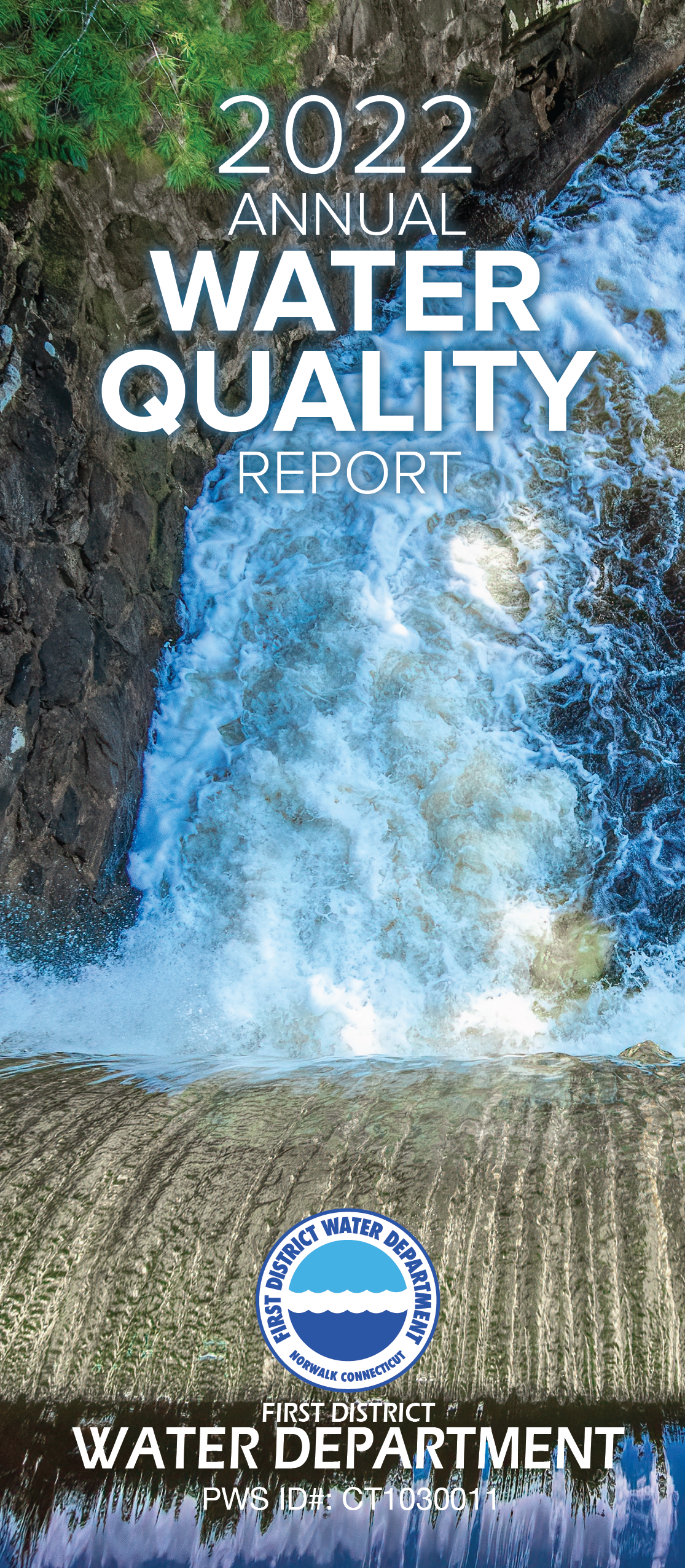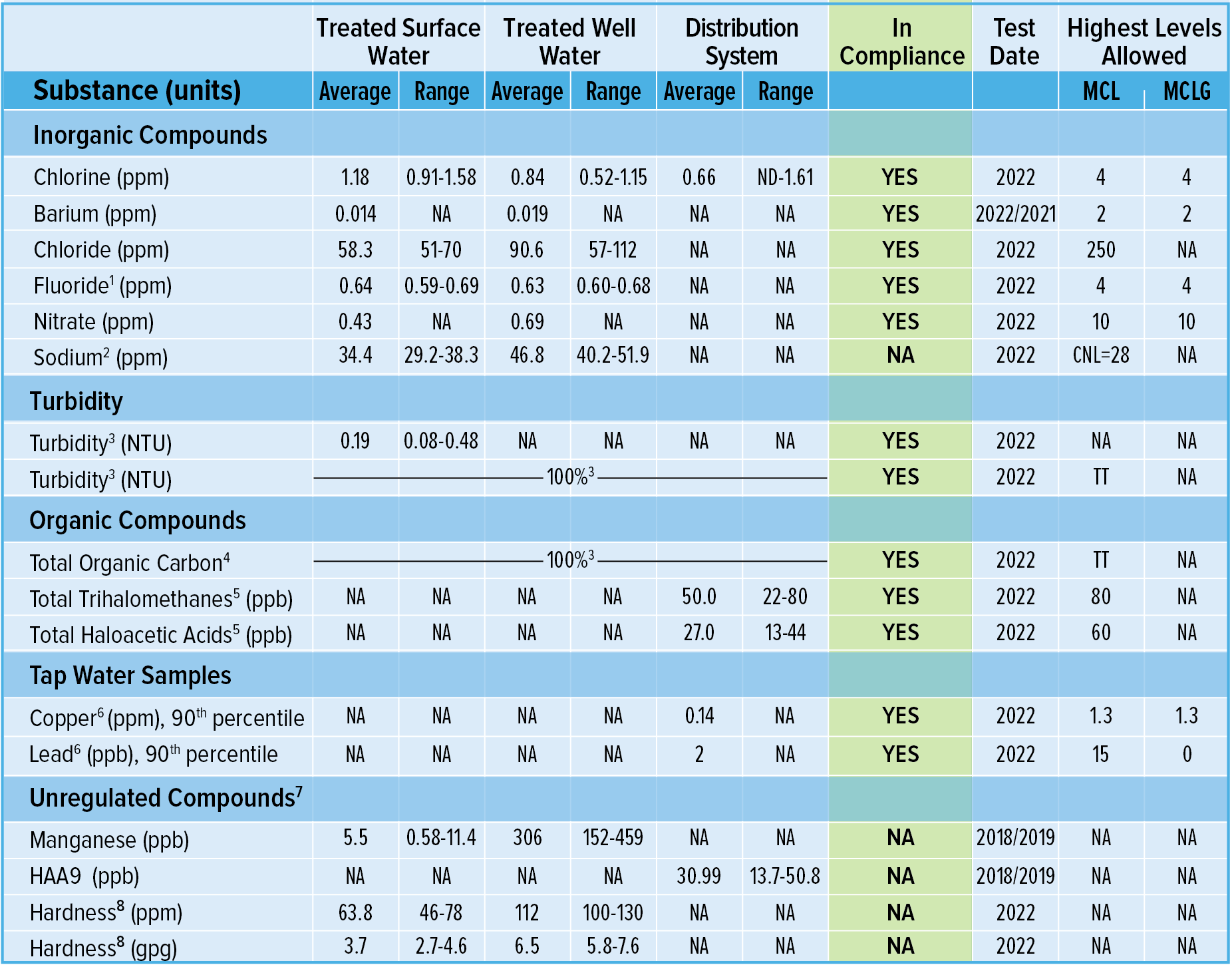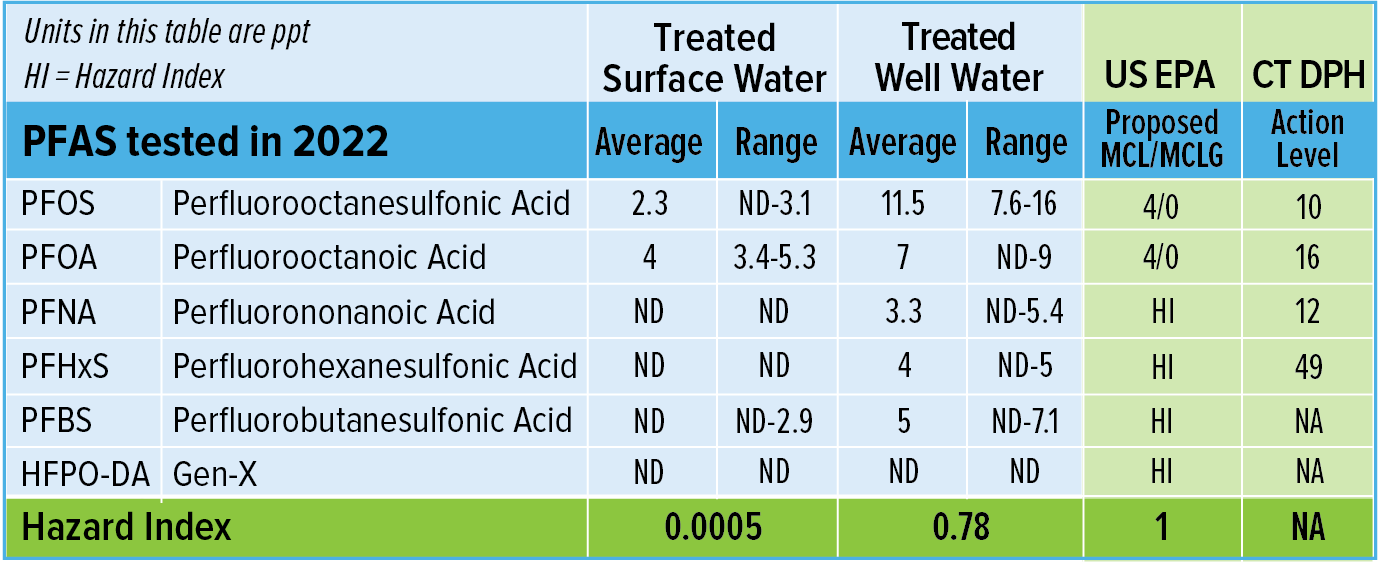Report an Emergency: 203-847-7387
2022 Water Quality Report
Letter to Our Customers
Dear Customer:
We are pleased to present you with this year's Water Quality Report. Despite the continuing challenges of the COVID-19 pandemic, the First Taxing District Water Department has again achieved the goal of meeting the very stringent water quality standards set by federal and state regulatory agencies. This report covers water testing performed throughout 2022.
Our top priority is to provide a safe and reliable supply of drinking water to all of our customers. Each year the water department's laboratory processes thousands of water quality analyses for compliance purposes. This testing includes the source water, the treated water as it leaves the filtration plant and well field, and the water as it travels through the distribution system pipes and into your homes and businesses.
Water quality and water usage have continued to be topics of interest in Norwalk and throughout our region. This report contains important information on water quality issues like lead, PFAS, and other contaminants. The droughts experienced in 2020 and 2022 have brought renewed attention to water usage. As a result, the District enacted Mandatory Sprinkler Landscape Irrigation Conservation Measures to ensure the long-term sustainability of our water resources.
You are always welcome to attend our monthly Board of Commissioners meetings in person at our main office, 12 New Canaan Avenue, Norwalk 06851, or remotely through ZOOM. The times and dates of meetings are posted on our website at firstdistrictwater.org/2023-boc-meetings. Please also feel free to call or write to us and to visit our website at www.firstdistrictwater.org for additional information.
Sincerely,
Commissioners, First Taxing District
Jalin T. Sead, Sr., Chairman
Thomas Cullen, Esq.
Elsa Peterson Obuchowski
2022 Water Sampling
During 2022 the FTDWD staff has taken thousands of water samples in order to determine the presence of biological, inorganic, volatile organic and synthetic organic contaminants. These samples were taken at the reservoirs, the treatment plant, and the well field, and also at representative sample sites around the distribution system. The table below shows only those regulated substances that were detected in the treated water. All of the substances found meet all state and federal standards. The most recent year sampled is noted in the table.
Footnotes
1 - Amount detected; ranges are monthly averages.
2 - There is no federal MCL for sodium but Connecticut has established a notification level of 28 mg/L. If you have been placed on a sodium-restricted diet please inform your physician of the sodium content in our water. For people on a regular diet this level of sodium is very low.
3 - Turbidity is a measure of the clarity of the water. It is monitored because it is a good indicator of the effectiveness of the filtration system. 95% of the samples need to be less than 0.3 NTU. The District met the regulation requirements 100% of the time. Amount is an average of the highest monthly readings.
4 - The District’s water met the required removal rate 100% of the time.
5 - By-product of chlorinating drinking water. Amount is the running annual average of quarterly measurements in the distribution system. The range represents the results of the individual monitoring sites.
6 - Tap water samples were collected for lead and copper analyses from 48 homes throughout the service area. The lead and copper results at the 90th percentile did not exceed the AL. No samples exceeded the AL.
7 - Unregulated Contaminant Monitoring Rule (UCMR) 4 monitoring was completed in 2018 and 2019. EPA uses the UCMR data for contaminants that are suspected to be present in drinking water and do not have health-based standards set under the Safe Drinking Water Act (SDWA).
8 - Hardness in water is a measurement of the calcium and magnesium (both nontoxic minerals) content in the water. Hardness is not a regulated substance but many customers ask about the hardness level of our water because dishwasher and hot water heater manuals may ask for this information, usually in gpg.
Acronyms and Definitions
AL (Action Level): The concentration of a contaminant which, if exceeded, triggers treatment or other requirements which a water system must follow.
CNL: State of CT Customer Notification level.
gpg (grains per gallon): unit of measure for hardness in water.
HAL (Health Advisory Level): An estimate of acceptable drinking water levels for a chemical substance based on health effects information. This is not a legally enforceable Federal standard, but serves as technical guidance.
MCL (Maximum Contaminant Level): The highest level of a contaminant that is allowed in drinking water. MCLs are set as close to the MCLGs as feasible using the best available treatment technology.
MCLG (Maximum Contaminant Level Goal): The level of a contaminant in drinking water below which there is no known or expected risk to health. MCLGs allow for a margin of safety.
NA: Not Applicable.
ND (Non Detect): Results below the method detection limit.
NTU (Nephelometric Turbidity Units): Measurement of the clarity, or turbidity, of water. Turbidity in excess of 5 NTU is just noticeable to the average person.
ppm (parts per million): One part substance per million parts water (or milligrams per liter).
ppb (parts per billion): One part substance per billion parts water (or micrograms per liter).
ppt (parts per trillion): One part substance per trillion parts water (or nanograms per liter).
TT (Treatment Technique): A required process intended to reduce the level of a contaminant in drinking water.
Compound Sources
Barium: Erosion of natural deposits
Chlorine: Water additive used to control microbes
Copper: Corrosion of household plumbing systems
Fluoride: Additive for strong teeth; erosion of natural deposits
Lead: Corrosion of household plumbing systems
Nitrate: Fertilizer runoff; leaching from septic tanks and sewage; erosion of natural deposits
Sodium and Chloride: Water treatment processes; road salt runoff; erosion of natural deposits
Turbidity: Sediment particles; naturally occurring iron and manganese; soil runoff
Per- and Polyfluoroalkyl Substances (PFAS)
Per- and polyfluoroalkyl substances (PFAS) are a group of man-made chemicals that have been manufactured and used in a variety of industries around the globe, including in the United States since the 1940s. PFOA and PFOS have been the most extensively produced and studied of these chemicals. Both chemicals are very persistent in the environment and in the human body – meaning they do not break down and they can accumulate over time. There is currently no Federal or State regulatory level for these compounds, however, in March of 2023, the EPA proposed regulations for PFOA, PFOS, and a combined hazard index for four other PFAS chemicals. These proposed levels are much lower than the former EPA Health Advisory Level of 70 ppt combined for PFOA and PFOS. These regulations are still in the approval process, and no action is needed by water utilities at this time. In June of 2022, The Connecticut Department of Public Health (CT DPH) also updated their guidance on PFAS in drinking water and developed Action Levels for four PFAS chemicals. Consuming water with PFAS concentrations greater than the CT DPH Action Levels over a long period of time may increase your risk of developing a variety of health effects. The CT DPH Action Levels are non-regulatory and not enforceable, rather they are guidelines that may be used to prompt protective measures.
The FTDWD has adopted operational measures to minimize PFAS levels in the finished water and has implemented an extensive monitoring program of our water. The majority of FTDWD water comes from surface water sources with low PFAS levels, with groundwater sources being used to supplement in times of high demand and dry weather, making up just 15% of our total water production. The FTDWD has plans to build a treatment system to remove PFAS from groundwater sources and is currently waiting for approval from CT DPH, along with securing grant funding before beginning this project.
More Information on PFAS
For more information on PFAS, including possible health outcomes, you may visit these websites:
Connecticut Department of Public Health Frequently Asked Questions about PFAS: portal.ct.gov/DPH/Environmental-Health/PFAS/PFAS
The Agency for Toxic Substances and Disease Registry’s website: www.atsdr.cdc.gov/pfas/health-effects/index.html
Basic information and links to informational resources: www.epa.gov/pfas/pfas-explained
Request
More Information
About Our Water
How FTDWD Water Is Treated

Water Quality & Sustainability
Conserve Water & Save Money
Fix leaks.
This one step alone could cut your water usage by almost 20 percent.
Indoors:
Trim a minute off the length of your showers. You’ll save on your water-heating bills, too.
Turn off the water while lathering up, shaving, or brushing teeth.
Use a bucket to capture shower and bath water while you wait for it to warm up. Then use it in your toilet tank or to water plants.
Only wash full loads in your dishwasher and your washing machine.
Outdoors:
Water outdoors only when and where needed.
Water on cloudy days, at night, or in the evening.
Follow the mandatory twice-weekly schedule for automatic irrigation systems, effective 4/1/23-10/31/23:
If last digit of your address number is an even number, the letters A – M or you have no address number: Water only on Sunday & Wednesday, 12:01 AM – 10:00 AM, or 6:00 PM – Midnight
If last digit of your address number is an odd number or the letters N – Z: Water only on Saturday and Tuesday, 12:01 AM – 10:00 AM, or 6:00 PM – Midnight
For more information visit www.firstidstrictwater.ort/irrigation-2023
Water Sources and How We Protect Them
Protecting the water supply at its source is the first step in achieving the water department’s goal of providing safe drinking water to its customers. The District’s reservoirs, located in Lewisboro, NY and New Canaan, CT, hold approximately one billion gallons of water. The source of the water is the watershed land covering 10 square miles in New Canaan, Ridgefield and Wilton, CT and Lewisboro, NY. Rainfall and snowmelt from this land are channeled into soils, groundwater, creeks and streams and then into our reservoirs. Disturbance or pollution on watershed land can directly affect the drinking water reservoirs.
Measures to protect the watershed land and reservoirs include frequent patrolling of the area. Open communications with both the local police and fire departments in our watershed towns is essential. We also work closely with local governments focusing attention on new land development in our watershed. When necessary we actively oppose unsuitable development and, where appropriate, work to get modifications to reduce the impacts of development. Each year our water treatment operators visit the properties on the watershed as part of our sanitary survey requirement.
Procedures to protect our groundwater sources in the Kellogg-Deering Well Field continue through the Aquifer Protection Area Regulations. The Norwalk Zoning Commission has used its authority to register and regulate businesses that pose a potential risk to our drinking water. The commission continues to provide updates to the registrants and work closely with the water department to protect our well field.
Source Water Assessment
A source water assessment performed by the State of Connecticut Department of Public Health indicated that the surface water source has a moderate susceptibility and the groundwater source a high susceptibility to potential sources of contamination. This does not imply poor water quality but does indicate the need for protection. The completed assessment report can be found on the Department of Public Health website:
http://www.dir.ct.gov/dph/Water/SWAP/Community/CT1030011.pdf
Additional source water assessment information can be found at the Environmental Protection Agency website at:





